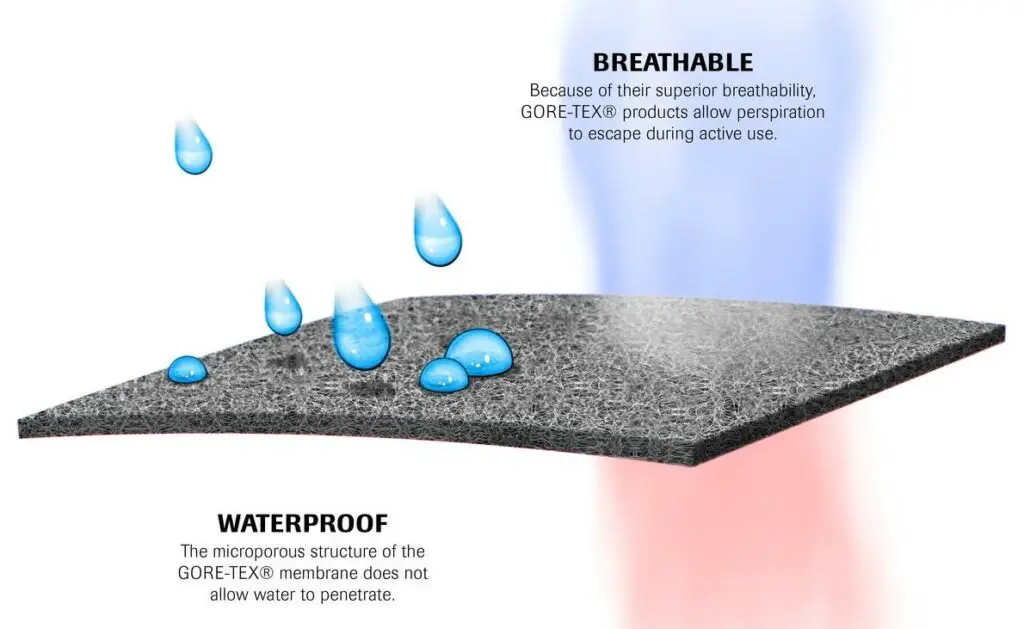Whether it’s work shoes, hiking boots, or casual shoes for men, women, or children, the right footwear should help your feet deal with a range of weather conditions.
You don’t want hot feet, but you also don’t want to compromise on support or protection. Therefore, you need to be smart while purchasing shoes.
When it comes to gore-tex shoes, they’re great for areas with damp terrain since gore-tex provides higher water resistance and keeps your feet dry and cool.
However, because gore-tex shoes aren’t as breathable as non-gore-tex shoes, they’re not suitable for dry and hot weather.

Gore-tex makes your feet hot since it has an insulating feature that makes it excellent for cold and damp conditions. Gore-tex fabric is windproof and breathable, however, it is not as breathable as other fabrics and the fact that they are highly insulated makes your feet too hot and sweaty in warm weather conditions.
But let’s not forget all the advantages gore-tex material has to offer which makes it reliable in extreme cold and rainy days. In this article, we’ll provide you with both pros and cons of gore-tex so that you can make a detailed choice before your next purchase.
What is gore-tex material?
Gore-tex is a three-layer sandwich, rather than a single material. The bread is made up of two layers of nylon with a layer of microporous teflon sandwiched in between. Which means it’s a fabric that keeps rain out while allowing sweat to escape.
There are a variety of reasons as to what makes gore-tex so popular:
1.) Thin membrane- An ultra-thin membrane lies at the heart of gore-tex technology. Over 9 billion tiny holes make up this membrane, which are 20,000 times smaller than a drop of water yet 700 times larger than a molecule of moisture vapour.
Water in its liquid state is impossible to flow through the barrier, while water in the form of moisture vapour from perspiration is allowed to pass through.
2.) It comes with layers- Gore-tex fabric typically consists of three layers: a traditional outer shell fabric and two independent gore-tex layers with similar but distinct waterproof-breathability features.
On the inside, there’s a hydrophilic (water-loving) inner membrane that enables water vapour to exit but not liquid water to enter. The hydrophilic layer collects perspiration from your skin and transfers it to the outside through diffusion.
A thicker outer layer consisting of a microporous polymeric polymer, such as teflon, sits next to the inner layer. This layer is hydrophobic (water-resisting), meaning it repels water from the exterior, even when it comes at a high speed or pressure or when the fabric stretches back and forth while you walk or run.
The hydrophobic layer does not absorb water from the outside, but it does enable sweat to escape from the inside via diffusion, just as the inner hydrophilic layer.
3.) Seams that are enclosed- The final step is to bind the seams. Sealed seams offer complete weatherproofing and prevent leaks in waterproof fabrics.
Most waterproof shoes contain sheets of tape on the inside that are used to repair any gaps that have formed around the stitching.
So what are the features of gore-tex that makes it suitable during cold and rainy seasons?
1.) They resist water and are highly water-proof- The capacity to keep dry even when walking through puddles or rain is the major benefit of gore-tex shoes. Each boot has an outer covering that serves to keep moisture and water out of the interior.
2.) Insulated for cold weather- These shoes and boots are typically an excellent alternative for winter trekking or cold weather excursions due to the insulation designed within them.
Even when the temperatures begin to drop, the inner layer will keep your feet significantly warmer for much longer.
3.) Waterproof- Waterproof shoes provide the primary benefit of protecting your feet from dampness and wetness. Outside water should not be allowed to leak inside the house.
This is especially crucial for those who trek in rainy weather since they want to be comfortable on the path. They will keep your feet cozy in chilly weather and can help avoid blisters and chafing.
4.) They’re breathable- Your body creates steam when you sweat, which is water in gaseous form. The molecules of gas aren’t truly connected together.
They can easily move around freely, which is why a gas fills whatever container it’s in. Because a water molecule is 700 times smaller than the holes of microporous gore-tex, when you sweat, the steam may readily travel from your skin, through the gore-tex fabric via diffusion, and out of your shoes.
Rainwater, on the other hand, is not the same as perspiration. It’s a liquid made up of droplets with billions of water molecules in each one.
A single water droplet is 20,000 times larger than the pores in microporous gore-tex, therefore it’ll never get through. Therefore, this is the secret of gore-tex fabric which makes it one of the most reliable fabrics in contemporary times.
Since we have understood the advantages of gore-tex, let us talk about it’s disadvantages too.
1.) Even under optimal circumstances, gore-tex does not enable perspiration to evaporate quicker than it is produced, especially when exercising or any other physical activity. This is especially true for your feet, which sweats profusely.
And if the surface of your shoes becomes saturated with water, which is unavoidable in prolonged rainy circumstances, this restricted breathability is totally lost.
When this happens, you’re effectively trapping all of your foot perspiration within your shoes, which may accumulate to the point where your socks get significantly moist leading to bacterial infections and foul smell.
2.) Builds up heat inside your shoes- The above mentioned point causes heat to accumulate within your shoes, making your feet feel hot. The membrane acts as a highly dependable technique for keeping your feet dry while they are exposed to rain.
3.) Durability issues- It’s worth remembering that gore-tex isn’t indestructible, and if the waterproof sock is torn, cracked, or just wears down over time, water may leak through, giving you all of the drawbacks and none of the benefits.
This is because the gore-tex membrane has been damaged in some manner, such as a puncture or tiny tear caused by improper footwear use and abuse.
Comparison Between Gore-tex and Non gore-tex shoes
1. Waterproof/Water-resistant
Gore-tex shoes are 100% water-proof, which does not let water pass through even a bit which makes them ideal for rainy seasons.
Non gore-tex shoes are water-resistant which means they repel water but if it rains heavily for long hours, the water is likely to get through the shoes.
See also: Waterproof Vs Water-Resistant Boots
2. Insulation
Gore-tex shoes keep your feet dry and warm even when strolling in the snow and provide insulation in severe temperatures.
Non-gore-tex shoes that aren’t water resistant may not be the best choice for trekking in the snow, as they aren’t as well insulated as gore-tex shoes.
3. Breathability
Gore-tex shoes do allow your feet to breathe, however the water-proof technology may interfere with the shoes’ breathability characteristics because they may not dry quickly while you are sweating profusely.
Because they aren’t as water-proof as gore-tex, they give more breathability, making them excellent for warm and humid temperatures.
Recommended Gore-tex shoes for you
1.) Adidas Terrex Gore-TEX Shoes
These shoes are definitely light and have great grip which makes them an excellent choice during rain and snow.
Check them out here-
- Molded Heel - Cup: Anatomical molded heel for improved support, fit, and comfort.
- Promoderator: Rock protection and stability.
- Sockliner: Molded sockliner to enhance comfort and fit.
- Mesh and synthetic upper for lightweight and comfort.
- Midsole: Lightweight EVA midsole for long term cushioning.
Prices pulled from the Amazon Product Advertising API on:
Product prices and availability are accurate as of the date/time indicated and are subject to change. Any price and availability information displayed on [relevant Amazon Site(s), as applicable] at the time of purchase will apply to the purchase of this product.
2.) ASICS Navy Shoes
The upper is made of gore-tex, which is both breathable and waterproof. It enhances the foot’s cushioning, durability, and offers great moisture control and breathability.
Check it out here-
- Built with Gore-Tex Upper which provides breathability and are fully waterproof.
- A SPEVA midsole material Improves bounce-back characteristics and decreases midsole breakdown
- The rear and forefoot gel cushioning system Attenuates shock during impact and toe-off phases
Prices pulled from the Amazon Product Advertising API on:
Product prices and availability are accurate as of the date/time indicated and are subject to change. Any price and availability information displayed on [relevant Amazon Site(s), as applicable] at the time of purchase will apply to the purchase of this product.
3.) ECCO Gore-tex Sneaker
This lightweight gore-tex technology is water-proof and provides good insulation in extreme cold temperatures.
Check them out here-
- GORE-TEX Technology for a breathable, 100% waterproof shoe
- Robust, motocross-inspired PU outsole offers traction and support, with an additional TPU insert for stability
- Reflective ribbons on the collar, tongue and pull tab offer increased visibility
Prices pulled from the Amazon Product Advertising API on:
Product prices and availability are accurate as of the date/time indicated and are subject to change. Any price and availability information displayed on [relevant Amazon Site(s), as applicable] at the time of purchase will apply to the purchase of this product.
4.) SCARPA Gore-Tex Shoes
These water-proof shoes are extremely comfortable for those long hikes in uneven and rough terrains, keeping your feet cozy and comfortable.
You can check it out here-
- Lightweight Versatility | Supportive construction and a lightweight, low-top cut make the Moraine an easy-wearing yet technically capable shoe for day hiking or fast-and-light backpacking adventures.
- GORE-TEX Extended Comfort | Waterproof protection that doesn’t sacrifice climate comfort for all-day wear in moderate to warmer conditions.
Prices pulled from the Amazon Product Advertising API on:
Product prices and availability are accurate as of the date/time indicated and are subject to change. Any price and availability information displayed on [relevant Amazon Site(s), as applicable] at the time of purchase will apply to the purchase of this product.
Conclusion
The main advantage of gore-tex shoes is that they will keep your feet dry and protected from dampness. Outside water is not allowed to penetrate inside the shoes. But it does have certain drawbacks.
However, depending on your needs and the area in which it will be used, you may make an informed decision before purchasing gore-tex, since it does have a lot to offer in terms of benefits.











